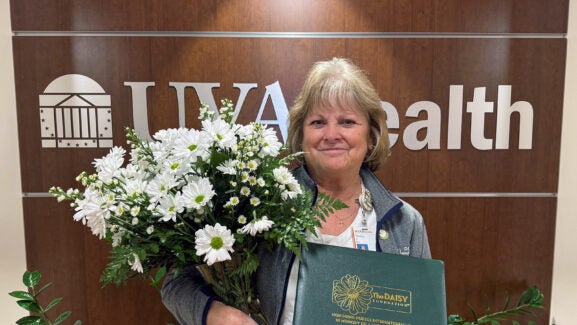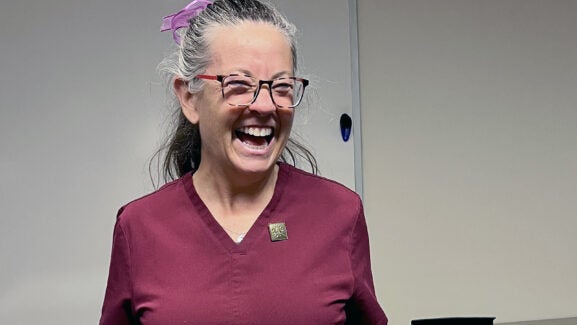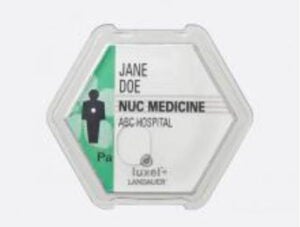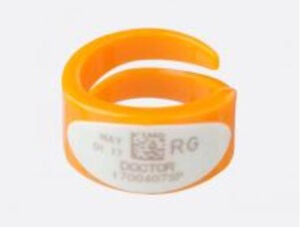
Safety and Security Spotlight: Monitoring Radiation Exposure
As part of our series highlighting the programs and people who work behind the scenes to keep us safe, this month we take a closer look at our Radiation Dosimetry Program, which leads the charge to monitor our employees’ exposure to radiation. “This is a complex program that requires an enormous amount of logistical coordination that I don't think is well understood or appreciated,” says Tom Leonard, Director of the Office of Environmental Health and Safety.
(Pictured above, l-r: Nick Dorrell, UVA Health Physicist; Mike Welling, Radiation Safety Officer and manager of the Radiation Safety Program; Asheleigh McClary, Program Coordinator; and Tom Leonard, Director of the Office of Environmental Health and Safety.)
Who Needs a Dosimeter?
If you are exposed to ionizing radiation on the job, you’re required by the Virginia Department of Health (VDH) to wear a dosimeter. “This includes anyone who uses radioactive materials and radiation-producing equipment, whether it’s diagnostic or therapeutic, anywhere within the University of Virginia,” says Mike Welling, Radiation Safety Officer and manager of the Radiation Safety Program.
The dosimeter records how much radiation you’re exposed to over a given period. The goal is for the total dose to remain below 5 rem. That’s the annual occupational dose limit for adults, according to the VDH. The goal of the Radiation Dosimetry Program is to maintain these levels — aka levels that are As Low As Reasonably Achievable (ALARA).
“During my seven years here, there has never been an issue with exposure levels,” says Welling.
Why It Matters
While equipment utilizing X-rays and the use of radioactive materials are essential to saving lives, they come with risks to those who work with them routinely. Exposure limits are set to protect you from those risks.
“The limits are designed to protect people from the short-term threshold effects of radiation that affect individual organs. For example, we don’t want to exceed the regulatory dose limit to the lens of the eye. This will reduce the risk of cataract formation. There are whole body limits to ensure that staff don't have an excess risk of cancer formation,” explains UVA Health Physicist Nick Dorrell. “These limits are set much below the threshold for those effects.”
Small Team, Big Impact
There are around 2,000 staff at UVA Health who wear a dosimeter currently. When it comes to radiation monitoring, wearing the badge is the easy part. The heavy lifting occurs behind the scenes. What you don’t see is that each badge has to be assigned appropriately, delivered to a department representative, and distributed. Then, at the end of the month — or quarterly, depending on the work area — each one has to be collected and sent off to an outside vendor for processing. The data from this processing must be closely reviewed and logged into a database. The process then starts all over again.
The three dedicated members of the Radiation Dosimetry Program, Welling, Dorrell and Program Coordinator Asheleigh McClary, not only manage this complex dosimeter distribution and review process, they work together to fulfill a variety of other duties, including:
- Providing safety training to applicable staff to educate them on the importance of and proper use of dosimeters
- Ensuring that everyone who needs a badge has a badge
- Providing a fetal dosimeter, lead aprons and more frequent monitoring to those who declare a pregnancy
- Counseling staff on how to limit their exposure if they are reaching levels that are not ALARA, and working with them to find solutions
- Auditing departments routinely to ensure all necessary staff are wearing badges and lead aprons appropriately
- Manning a 24/7 emergency hotline for staff who have questions or concerns
That’s not all. This team is also part of the larger UVA Radiation Safety Program and the Safety and Security workgroup for managing hazardous materials and waste. They work to ensure compliance with VDH regulations and Joint Commission requirements. And they continually evaluate new strategies to limit radiation exposure as science advances and new technology is adopted.
“We're always looking at ways to reduce exposure,” says Dorrell. “We just purchased new shield equipment for a nuclear medicine therapy and it’s working really well.”
A Safety Culture
For all of their efforts, even those that go unnoticed, Dorrell and Welling agree that it’s rewarding knowing that the Radiation Dosimetry Program works. “When we show people their exposures and work with them on ways to reduce that, it’s rewarding to see people begin to understand the safety culture here at UVA and to understand that Nick, Ashleigh, and I are here to help them out,” says Welling.
Another thing this team agrees on: they need your help. If you’re issued a dosimeter, wear it!
Learn more about our Radiation Safety Program and dosimetry requirements, and get more information on the UVA Safety Culture.
Interested in being part of the Safety and Security workgroup for managing hazardous materials and waste? Contact Tom Leonard at tleonard@virginia.edu.
Radiation Dosimetry Program: By the Numbers
- 1,900 | Individuals issued dosimeters in 2023
- 11,456 | Dosimeters exchanged in 2023
- 8,000 | Average number of steps the Dosimetry Program Coordinator walks per day to distribute dosimeters
- 33,037 | Pieces of lead protection tagged and tracked within our System as of January, 2024
In case you missed it

Latest News





